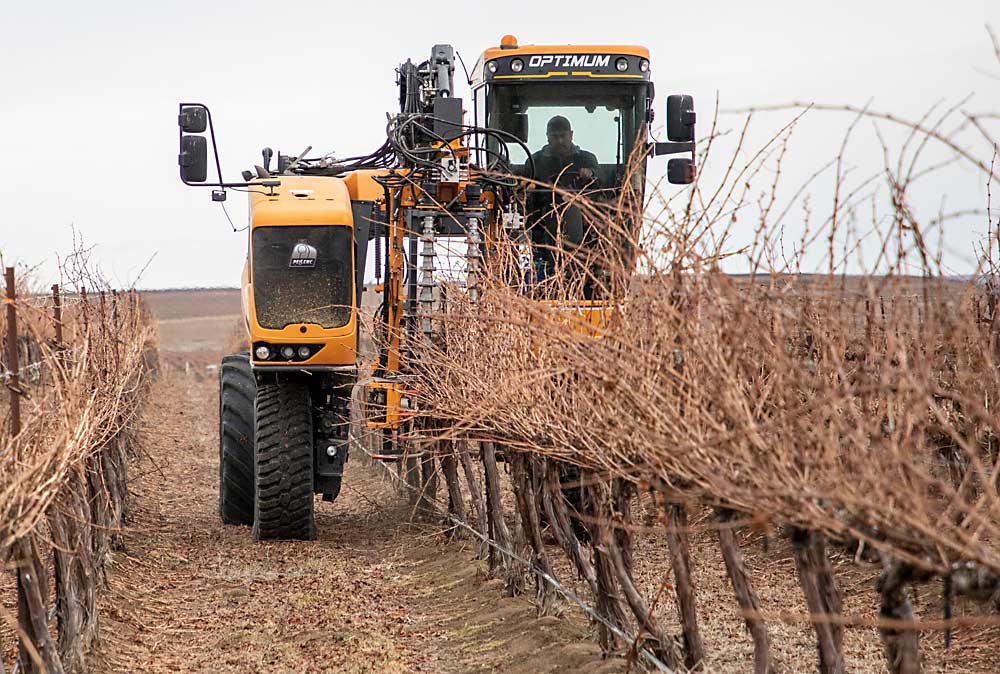
Labor is expensive, no question. And Coyote Canyon Vineyards liked the idea of taking care of their winter pruning with a machine.
In theory.
However, after a few years of trial and error, the high-end Washington wine grape producer has pulled back from mechanical pruning to leave some work for its skilled hand crew, seeking a balance between the machine and man.
“We are planning on mechanization to facilitate for our crew,” said Todd Chapman, vineyard manager for the 1,300-acre Horse Heaven Hills business.
Coyote Canyon uses a Pellenc TRP mechanical pruner that worked as efficiently as the vineyard hoped. Guided by a light bar that follows the cordon, horizontal overlapping blades cut vertical shoots to a desired height, while mulching blades help remove the tall growth from trellis wires.
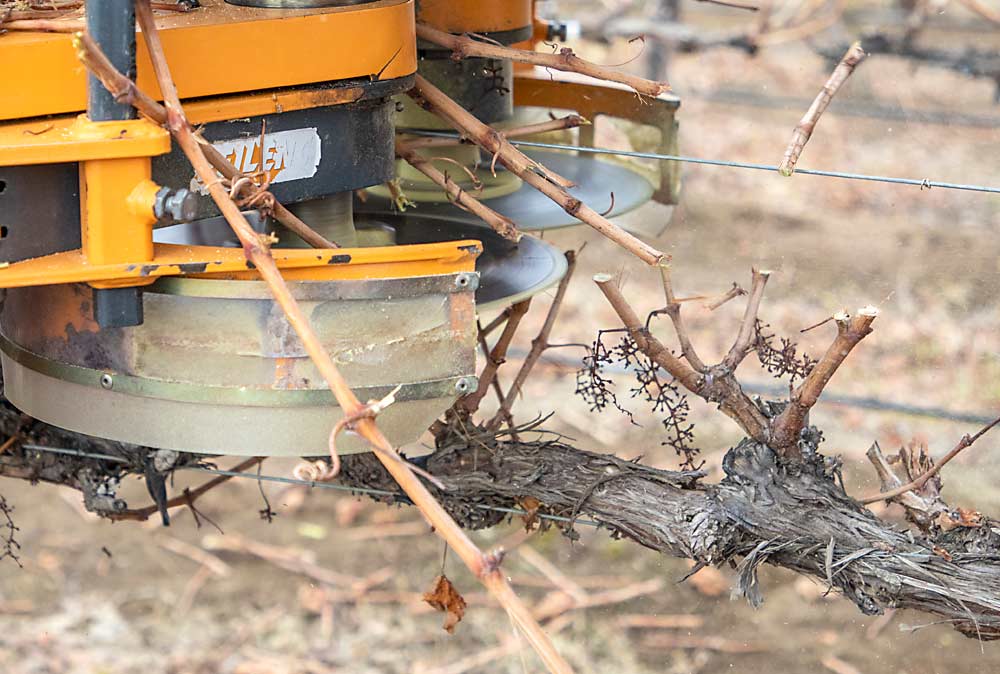
However the cordon ended up pushing congested uprights that led to inconsistent sun exposure and air flow, resulting in a canopy that was harder to manage later in the year, Chapman said. The next year, Chapman and his supervisors had to lower the blades to make up for it, each year getting closer and closer to the cordon and removing quality fruit positions for the upcoming spring. It saved time and money one year but cost extra time and money the following years.
“It was a mistake,” said Tony Flores, a crew supervisor.
But, Coyote Canyon didn’t abandon the machine. Chapman instead instructed his operators to raise the horizontal blades a good 10 inches above the cordon and “preprune” with the Pellenc to clear away a lot of the long canes. The operators also make a pass with the drum-shaped shoot thinner for winter cane removal. (The vineyard also uses the shoot thinner in the spring to clean the undersides of the cordon, again, to make access easier for hand crews.)
The machine removes a lot of rubble, a task that chews up a lot of time for hand crews. It’s also dangerous.
Those hand crews instead focus their energy on carefully choosing and preparing the right fruiting positions for the upcoming season. Depending on variety, Coyote Canyon likes each shoot between 4 and 6 inches apart with two to three buds on each.
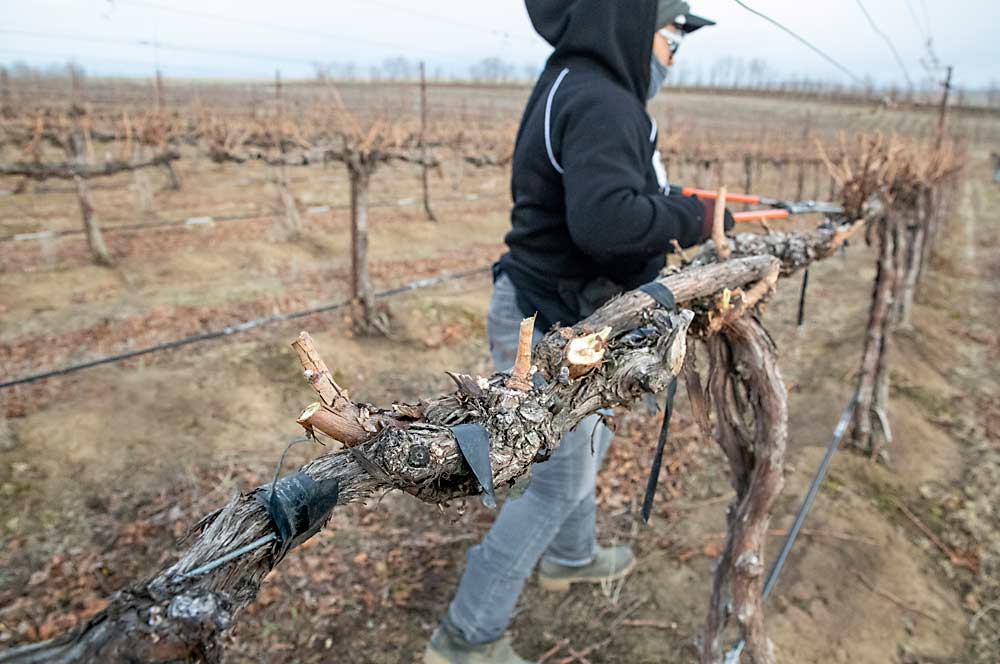
Chapman praises the skill and speed of his hand pruners; they quickly and cleanly work a block nearly to perfection. He pays them piece rate — some of them work out to $250 per day. Hand labor is more expensive, but combining it with the machine saves him money in the long run, he said.
Meanwhile, the mechanical pruners don’t work on all varieties and training systems. Old vines are sometimes so hard and woody that the blades won’t cut through them. And the vineyard has some that are so high-end, only hand labor will do, Chapman said.
Pellenc also makes a prepruner for the work Chapman describes. Coyote Canyon is ordering one that can do two rows at a time. Chapman said they plan to sell one of the vineyard’s two TRPs and keep the other “in our back pocket.” The economics of vineyard labor could continue to change, especially with Washington’s staggered overtime mandate that began this year.
Washington State University research favors the use of mechanical pruning in general, said Jim Harbertson, a professor of enology at the Wine Science Center in Richland. One-year comparisons of fruit phenolics, sensory profiles and alcohol levels in wines made from mechanically pruned grapes showed little difference from hand-pruned controls.
“These wines really weren’t that different from each other,” Harbertson said in mid-February at a convention hosted by the Washington Winegrowers Association. “I think you can move forward, and yes, you can mechanically prune.”
Brittany Komm, senior viticulturist at Precept Wine near Benton City, spoke about dormant pruning and mechanization during the conference session. She uses prepruning to pave the way for her hand labor, and her recommendations each year are similar to Chapman’s — two to three buds per shoot with 4 to 6 inches between each.
Komm advised growers to assess for cold damage in sensitive blocks before pruning at all, mechanical or by hand, and adjust accordingly. She suspects some growers will see bud death due to a New Year’s Day cold spell. The Benton City area saw a record low of 0.2 degrees below zero, according to AgWeatherNet. Pruning strategies will also vary with variety, tier, sparkling or still wine and a host of other factors.
“There is no such thing as normal anymore,” she said.
Komm said Precept is considering full mechanical pruning, first for production blocks and maybe later for high-tier grapes. However, much of the Washington industry’s acreage is not ready for the shift, she said in a follow-up interview. Many vines are older with crooked cordons and trunks on trellis systems built for hand labor. The pruner blades could accidentally cut deep into a plant or get caught in trellises, risking the trellis and the machine blades, Komm said. Machines need solid consistency to work.
“It’s not always going to be close and pretty out there,” Komm said.
—by Ross Courtney

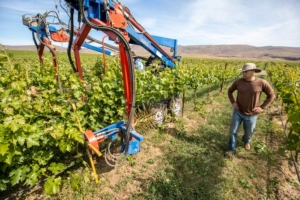
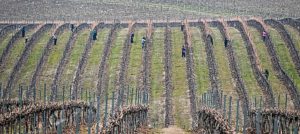
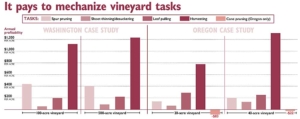





Leave A Comment